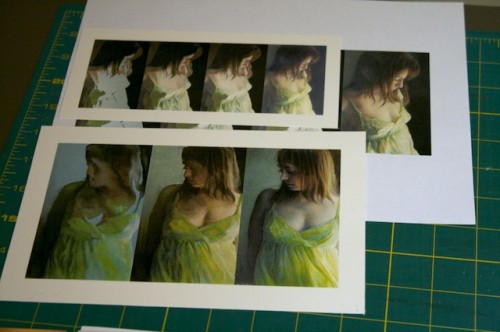Everyone now and then I like to google "sanded papers" to see if any new products are out. Most of my artwork is on Artspectrum Colourfix paper, with a few pieces on Pastelbord and Fisher 400. I've tried UARTs and Wallis, and they didn't work for my style. I've always liked drawing on the Canson Mi-Teintes papers in the past - especially the multi-colored tablets that give you a variety of hues - but these were textured (but not sanded) papers. Some colored pencil artists (Sue Obaza comes to mind - check out her work in Strokes of Genius 2) do amazing things to bring out the texture of the Mi-Teintes paper; for me, though, I love the pumice in primer effect of Colourfix, and the speckled finish it produces. You can imagine my delight when my google search found Canson Mi-Teintes Touch papers. I had to order some! The Mi-Teintes Touch look and feel very similar to Colourfix. There is a white, unprinted border around a colored, printed area which is toned with a fine grit sandpaper feel. The available colors are many of the same colors in the usual Mi-Teintes line up (which is awesome!). Here's my personal assessment of how they compare side by side with Colourfix:
- Mi-Teintes full sheet sizes are slightly larger (22" X 30") vs. Colourfix's (18" x 27").
- Dick Blick's website offered 14 colors for Mi-Teintes, vs. 20 colors for Colourfix
- For the 3 sheets I ordered (Light Blue, Flannel Gray, Twilight) of Mi-Teintes, the colors were a little more vibrant and saturated than Colourfix colors, which tend to be subdued.
- The Mi-Teintes papers have the "Mi-Teintes Touch" logo screen printed in the white border of each sheet, while Colourfix borders are unprinted
- The tooth feels similar to the touch between Mi-Teintes and Colourfix. A few test scribbles showed it to be slightly more prominent in the initial layers than Colourfix.
- The most striking difference (and this is my biggest complaint about Colourfix in general) is in the overall quality of the screen print area. The 3 Mi-Teintes sheets all had perfectly rectangular printed blocks of color, with no splatters, no chips, and no irregularities. The color was uniform in each block. Running my hand across the surface, the grit was uniform in each block. From my experience with Colourfix, the variability is high both for consistency of grit and quality of the screen print area. Some pieces of Colourfix have very little grit, and others are more like sandpaper. Colors often have splatters and small voids. The printed edge border is somewhat irregular (which I actually kind of like). It has been frustrating to buy a pack of Colourfix paper and have every sheet have some type of printing defect, though. It was nice to have 3 perfectly uniform sheets of Mi-Teintes. I'll be curious to see if this is the norm with Mi-Teintes as I try more sheets.
Here's a few pics of the sheets and some test scribbles. Now I just need to figure out what my first project will be!





















